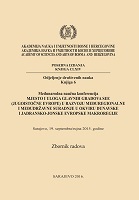COMPOSITE INDEX FOR QUALITY OF LIFE IN MUNICIPALITIES IN FEDERATION OF BOSNIA AND HERZEGOVINA
COMPOSITE INDEX FOR QUALITY OF LIFE IN MUNICIPALITIES IN FEDERATION OF BOSNIA AND HERZEGOVINA
Author(s): Elma Šatrović, Ensar Šehić
Subject(s): National Economy, Methodology and research technology, Socio-Economic Research
Published by: Akademija Nauka i Umjetnosti Bosne i Hercegovine
Keywords: composite index; Federation of Bosnia and Herzegovina; Quality of Life; Ranking;
Summary/Abstract: This paper uses data on 79 municipalities in the Federation of Bosnia and Herzegovina (FBiH). The aim of this paper is to create quality of life (QoL) indicator for municipalities based on quantitative criteria and to rank them based on index scores. Data on municipalities were obtained from public databases. Variables that are used are: number of doctors, number of hospital beds, number of students in secondary schools, number of teachers in secondary schools, employment rate, unemployment rate compared to active population, GDP per capita and area covered by roads (km2 ). In order to rank municipalities, the variables were divided into five categories, or indices: health, education and training, work, economic well-being and services. The first method that is used is mean-standardized rank method, where each of the indices are standardized, so that the differences between each of the indices are re-scaled to be consistent across each index. The standardized indices are then averaged and used to rank municipalities according to the mean. All indices were weighted equally. Since a relationship between the population of the municipality and the placement in the overall ranking seemed to appear, a population adjusted method was used to account for this, and the indexes were regressed. Results of the first method identify top 3 municipalities: Grad Mostar, Tuzla and Centar-Sarajevo. Results of the second method indicate that the actual change in rank is negative for the larger municipalities – they did not rise as much as expected, and the actual change in rank is positive for the smaller municipalities – they fell in rank more than expected. Comparison of two methods indicates there is a fair amount of agreement between the two ranking methods in the top municipalities. However significant differences appear in the bottom municipalities.
- Page Range: 275-289
- Page Count: 15
- Publication Year: 2015
- Language: English
- Content File-PDF

